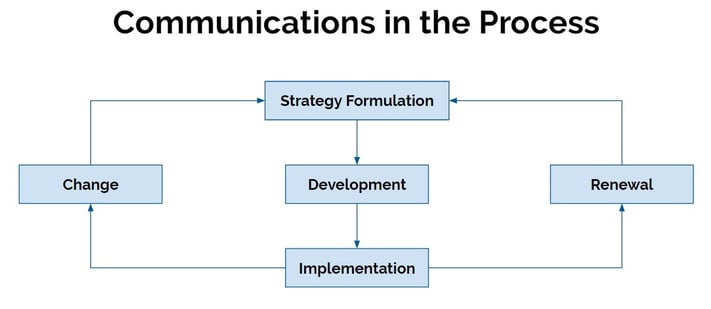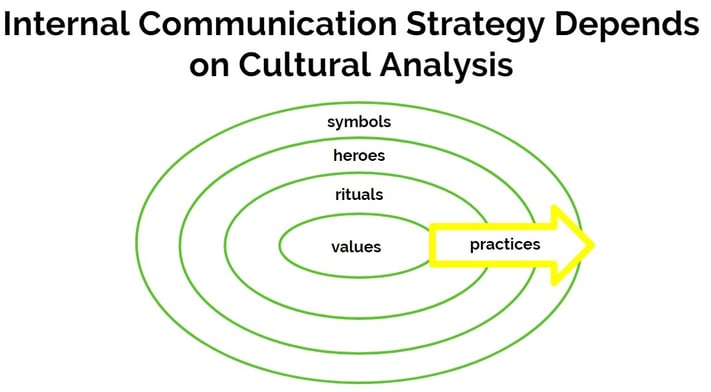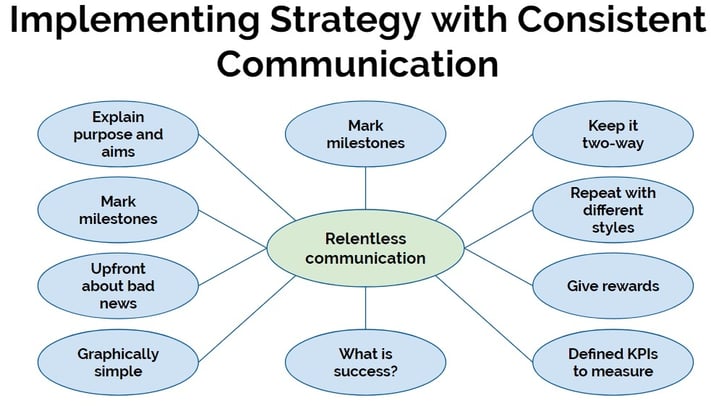
Poor or ineffective communication is one of the key barriers to change in organisations.
At one stage or another, every company experiences this.
In my role as Global Partner Program Manager at HubSpot, I've recently taken on a new challenge - to run the internal communication for our Partner Program.
I come from a PR background so communications is nothing new, however, during that time I dealt with external stakeholders not internal.
So to step up my game for my new work focus, I've been reading quite a few books on the topic of internal communication (IC) and I also spent a full day in training on Strategic Communications: Making Strategy Happen with the Institute of Internal Communication in London last week.
As always, I want to share my learnings from the course with you - today, we'll cover key principles and the link between strategy and communications; next week, we'll talk about how to create a strategic international communication strategy.
Before I move on to today's topic, I want to first list out my key learnings from the day:
Key Learnings from Strategic Communications: Making Strategy Happen
- Whatever your external activities and strategy are for customers they must reflect internally to employees too in terms of messages, operations and processes - your staff make strategy happen so they need to live and breath it and most importantly feel it and experience it for themselves.
- How execs and managers behave is going to determine how staff will behave - if management doesn't listen to feedback and analyse its actions to improve, staff won't either.
- Comms must be based on trust - if you say something to me and I inherently don't believe you, there's no point in doing comms at all; you have bigger issues to fix.
- Make strategy front and centre and don't forget the little, everyday things like putting it up on the wall or on stickers on laptops etc.
- Ask for feedback more often - do surveys to find out what people take out of the messages you deliver and the channels you use; also find out the type of materials that's been used generally in your organisation - e.g. the degree to which your org has become excessively dependent on emails or meetings which might no longer be contributing but becoming a blocker.
- Do a SWOT for your comms system - find out what's currently working well vs. what's not in your organisation when it comes to internal communication and how it's being run.
Making Strategy Happen: Principles for Strategic Internal Communication
What is strategy?
People have different definitions of strategy so you need to know what people mean by it for themselves.
Strategy refers to the large game plan to lead not just the battle but the whole war. With an evolving strategy you avoid the risk of becoming stale.
Strategy is about deciding what to do based on strengths, weaknesses, opportunities and threats to find how the business is going to compete through a deliberate plan of action that will develop a company's sustainable, strategic competitive advantage and compound it.
Strategy is about being different in delivering a unique mix of value. But it's important to bring in the world within this vision not just ourselves - strategy needs to be valued by internal and external stakeholders. Simply being different is not good enough - it needs to deliver value to customers.
Strategy needs to be simple as a process to use to achieve success for the organisation. A 200-300 page document is not strategic in its thinking, it's too complex.
Strategy also puts boundaries on the business. It's equally important to know what we're not going to do not just what we're going to focus on.
Strategy offers the opportunity to reinvent and do the right things correctly.
It should be based around VUCA - volatility, uncertainty, complexity, ambiguity - and it must reflect the environment you work in.
A company's strategy represents the vision and broad route to achieving it but it will only succeed if it's properly presented and supported by continuous, effective communication.
Particularly in times of change, communication is essential - both externally and internally.
Strategy and Communications
Strategy is about three things: planning, execution and communication.
However, communication is often left undone or underdone in contrast to the other two. But communications must show what's different and what's important. You can have a strategy and it can be excellent, but if it's not communicable, then it's not a strategy because strategy is essentially a communication of certain group's vision on what the organisation is going to do in the future. If I can't get the strategy from one head into another, then it's not a true strategy and it doesn't have any inherent value.
Are strategy and communications the same thing?
They are very closely aligned. Strategy needs good insights that inform it and communication has a huge role before strategy formulation because the info that you take in, the knowledge that you acquire about customers, employees and other stakeholders and their needs helps formulate the strategy because otherwise you can't develop a strategy that truly is based on those needs. It becomes a mismatch. And it's up to the comms person to say "No, this strategy is not going to work; it's mismatched."
Strategy frames a vision that those working in the organisation can support and those outside can believe.
Communications must match strategic intent and what the strategy means.
How do we turn strategy into something you can communicate?
Two important areas: comms in forming the strategy and maybe shaping it, and comms in actually turning the strategy into something that you can communicate.
Internally, to get your staff to believe in the strategy, you have to have high-quality internal comms with quality standards internally just as externally. The value you want you to expose outside needs to be aligned with the value inside and also organisations need to walk to the talk internally - how you operate with clients must mirror how you operate with your staff.

Looking at the above image, all the arrows are communications that turn strategy into something meaningful and aligned, however, the vectors shouldn't drift off in their own direction at any point.
So what are strategic communications?
Strategic communications drive as well as give information and insight (knowledge from data) to the strategic process.
- Work that communicates the strategic intent to key audiences in their language - informing.
- Expressing the strategy to the world - shaping.
- How we find out if we are achieving the strategy - understanding.
Strategic IC give out your strategy in such a way through your systems and comms so that people begin to believe that that's the world that they live in and how it functions. Strategy becomes ingrained.
Stategic communications aim to put a communications system in place that supports the organisation's strategic aims.
Two components/levels of strategic comms:
- Communicating the strategy to staff and stakeholders - telling them about it.
- Communicating the strategic intent through staff - staff must internalise the strategy and communicate it to the wider world. They must believe that's the way they should work. Treat staff as a customer/client and value their inputs in exactly the same way. Your customer values and principles must translate back to those of employees - when you plan a customer campaign, think about how that translates into employees. You need to walk the talk internally and externally and always come up with the metrics to measure this. What does the strategy mean to each individual, how do they relate to it? Frame stories to communicate the strategic intent. Have strategy on the walls, on the coffee machines, basically you want the elements of the strategy to be enforced everywhere.
What isn't strategic communication?
- reactive communication - trying to fix the comms system all the time.
- attempting to spin - how do we put a good thing on bad news; don't hide or dress it up, just say it.
- repetitive processes - unmeasured or untested comms, e.g. sticking to magazines when no one reads them because that's the way we always do.
- taking communications opportunities as they arise - because something is happening, we'll just tag comms onto it; but comms must fit into overall strategy and you shouldn't be doing something (irrelevant) just for the sake of it
- production-based targets (number produced) - unimportant metrics that don't tell you anything instead of focusing on the why e.g. number of followers but why do they follow you.
- try anything once - when you hear someone else doing something, you jumping on it just because others are doing it and because it's the next big thing.
Internal communication strategy is not a linear process and it involves:
- Understanding strategy and what we want to achieve and framing it.
- Turning these objectives into a plan to communicate with practical measures
- Defining measures for the plan - has it happened?
- Defining measures for the strategy - has it achieved its intention?
More on communication strategy next week.
Issues for Comms Strategy
Leadership often undervalues the importance of communication both in formalising the strategy and also in helping making it happen. Failed leadership through poor communication becomes a key barrier to change and progress in organisations.
But leaders must learn to lead communications:
- Leaders must be convinced of the importance of communication especially when it comes to change.
- Leaders must agree that communication must be planned and part of the strategy and it needs to be properly resourced and professionalised.
- Leaders must demonstrate the message.
- Leaders must communicate strategy relentlessly:
- Purpose/reason/meaning/measure - every message must include the mission/vision and has it in its context (consistency)
- Use a variety of media - does this fit the message and the strategy and is this the right tool to use to communicate that (e.g. images, email, video etc.)
- Ensure consistency of messages - must speak the language of the people who will be receiving the news at the stage of their are in terms of their knowledge on the change itself and it also needs to be reinforced again and again. Key messages are there all the time.
Culture
The necessary key ingredient that holds an organisation together is its culture. And culture is created through intercommunication.
Communications strategy often aims to develop or sustain an organisation's culture. Culture is about the way we do things around here. It has two elements: national cultures and organisational cultures (with subcultures).
Culture determines communication's success.
A question to ask is What is the overarching culture that we want to have?

But you first need to understand what your current culture is. You should analyse it and ideally survey it.
Here are some things you want to find out about your organisational culture:
- Identify the national cultural dimensions by Hofstede:
- power distance
- collectivism vs. individualism
- masculinity vs. femininity
- uncertainty avoidance
- long-term vs. short-term orientation
- indulgence vs. restraint
- Identify your organisational dimensions:
- process vs. results oriented
- employee vs. job oriented
- parochial vs. professional
- loose contract vs. tight control
- normative vs. pragmatic
- Identify other dimensions that may be relevant:
- us vs. them
- defend our area
- open to new ideas
- honest managers
If you have strong organisational culture, that will supercede the national one.
Key strategic messages must be culturally translated. They must deliver consistent meaning in all contexts and you need to listen to how they are being received because culture hangs on. It seeks out remnants of old culture and has ceremonial burial. It gives honour to a system that has served well but must now change.
Change
People won't change unless they are convinced the change will result in an improvement (often for themselves). Different stakeholders may need the vision communicated in different ways to match their special needs. Strategic communication enables this because it turns the vision into something understandable, something that staff can believe, internalise and eventually live. And that's the essence of change and changing behaviour.
Effective communication ensures that consistent, credible and continuous information flows through the organisation. When such information is shared, employees develop a common understanding of the business's ends and means. Communication, therefore, helps to overcome resistance to change.
Measurement
Measurement demonstrates effectiveness; it shows a level of penetration; it clarifies where difficulties are arising; it shows what adjustments are needed; it shows how change has worked or hasn't. Use measurement to keep your own unit and organisation on track and also as a way to communicate to others what it is that you are doing and how the org is responding to it.
A key thing you must measure is the level of trust between key stakeholders - between management and staff as in the degree to which staff believes that management will act upon what they're saying.
However, the only true measure of your internal communication and its effectiveness is impact - what's the value that you're delivering?
Communications must listen all the time and do a communications gap analysis:
- What's working?
- What is changing?
- How are plans drifting?
- Are they moving away from strategic intent?
- Are managers walking the talk?
- What about change survivors?
- What about those who avoid change?
- Any saboteurs?
- Is anyone undermining the messages from outside the organisation?
Everything has to be measured.
The comms plan must have clear objectives aligned with the strategy and tactics that fit the why so that you can measure whether you've achieved the objectives. This is how you will support the strategy and these are the measures that you will use to say that comms is effective.
Conclusions
Strategy must be made explicit:
- in the way people talk
- through the organisation's performance and reward methods
- in meeting's ground rules, name standards, message boards etc.
- through the creation and promotion of new heroes and myths
- through constant reinforcement by senior managers
Internal communication must have 5 key competencies in place:
- insight - complex world needs understanding
- focus - on the right things
- alignment - all elements in with strategic focus
- execution - speed in turning strategic vision into realities, otherwise people will put their own frame of reference
- renewal - redo the above over and over; quicker and quicker

What organisations need to succeed:
- integrated, long-term communications programme
- link communications efforts to organisational objectives
- make sure employees understand and contribute to organisational goals
- measure communication efforts to manage them properly
Next week we'll cover creating an internal communication strategy.
What are your principles for internal communication?







